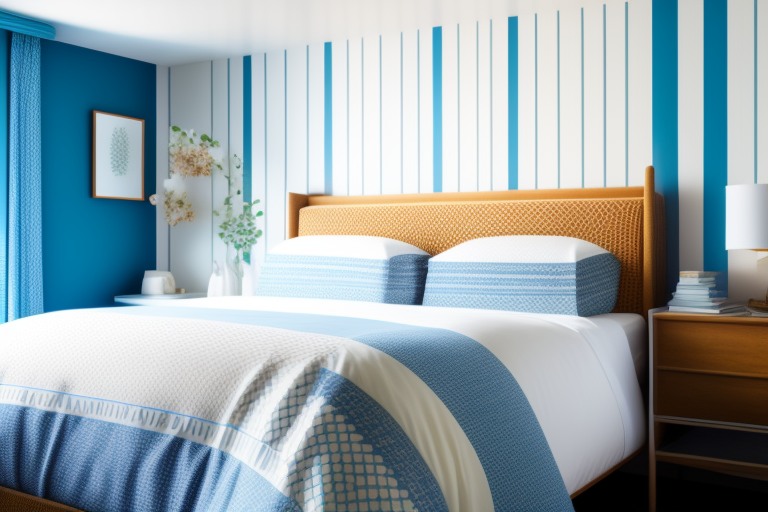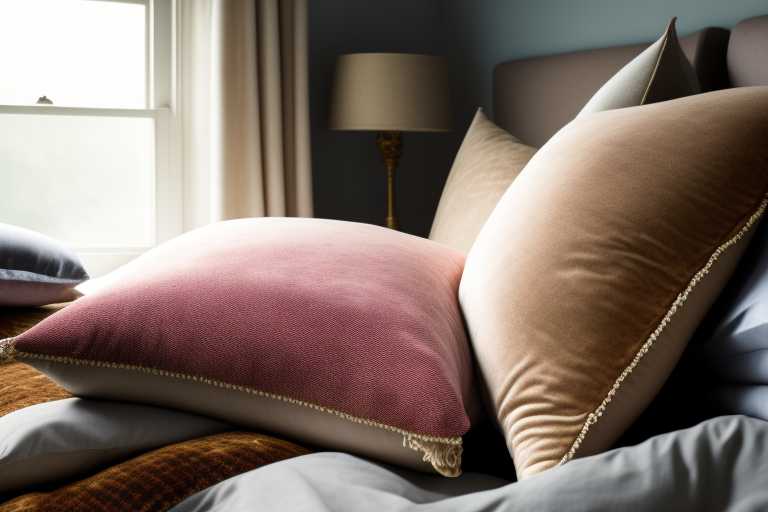Do you ever wish your small bedroom could feel more spacious and airy? The right bedding can work visual magic to make a room appear larger than its actual square footage.
With some strategic choices in colors, fabrics and styling, your bedding can create an illusion of openness even in a cramped space. The goal is to make the eye focus on the peaceful expanse of the bed rather than the room’s boundaries.
This beginner’s guide will teach you everything you need to know about choosing bedding that makes your bedroom look bigger. Let’s explore the design elements that can transform your sleeping space from claustrophobic to spacious.
Understanding Your Room’s Dimensions
The first step in your bedding selection is assessing the actual proportions of your bedroom. This will determine the best techniques for maximizing the illusion of size.
- Small square footage calls for choices that recede visually to expand the space.
- Long narrow rooms need strong focal points to draw the eye down the length.
- Tall ceilings can handle bolder patterns while low ones benefit from simplicity.
Take measurements and note the room’s layout before shopping so you can choose bedding suited to your needs. The goal is to use your bed as a tool to direct sightlines and expand boundaries.
Harnessing the Power of Color
Color wields immense influence over how open and airy a space appears. It’s one of the most potent tools in your bedding arsenal for controlling visual perceptions.
Light Colors Maximize Space
Pale and neutral shades make surfaces appear to recede and rooms feel larger and brighter. Stay away from rich jewel tones or anything too saturated.
- Soft whites optimally enlarge space and reflect light. Choose warm or cool undertones to complement the room.
- Beiges, creams and pale grays effortlessly recede for an airier effect.
- Pastels like lavender, powder blue and buttery yellow work beautifully in a soft, elegant palette.
Monochromatic Schemes Streamline
Sticking to a narrow color family gives the eye less to process and keeps furnishings looking continuous. The space will read as one expansive unit rather than choppy sections.
For example, layer white sheets with a downy white duvet and pile on creamy decorative pillows. The uniform palette minimizes visual boundaries.
Contrasting Colors Define Sections
Alternating strong colors differentiation sections of a room. This can trick the eye into perceiving individual spaces as larger than the whole.
Try a navy blue duvet with crisp white sheets. The contrast makes the bed feel like its own open environment compared to the surrounding walls.
Fabric and Texture Effects
The fabrics and textures you choose for bedding impact the room’s ambiance just as much as color. Tactile elements like embroidery and sheen also draw the eye to make spaces appear larger.
Lightweight Fabrics Breathe
Airy, gauzy linens have an ethereal quality that makes rooms feel more open. Light reflects and travels through the sheer material in an enlarging effect.
Crisp cottons and breathable linens in solid colors work beautifully to expand small spaces. For a romantic feel, try layers of floaty cotton voile or silk.
Matte and Tactile Textures Ground and Define
Satin, velvet and textured materials create solidness and dimension. This defines the bed as its own grounded environment with presence and weight.
Luxurious tactile bedding makes the bed feel like an opulent oasis compared to the room boundaries. Your sleeping space takes on an expanded, almost Bohemian ambiance.
Glossy Sheens Reflect Light
Satin and silk sheets with shiny finishes reflect light around the room and create liveliness. This draws attention to make the bed feel like the main event while boundaries recede.
There’s a fine line between brightening and overwhelming. Stick to sheets and decorative accents in metallics and gloss no larger than 20% of the overall scheme.
Design Concepts That Expand Rooms
Certain design approaches inherently make spaces feel enlarged and welcoming. Keep these concepts in mind as you plan your room and bedding.
Minimalism Cleans Visual Field
Pare down bedding to the essentials in muted neutrals without patterns or frills. This cleansing of the visual field makes the entire room feel more open and breathable.
Stick to one down insert, duvet, sheeting set and coverlet for clean lines. Decorative accents should blend in rather than compete for attention.
Modern and Contemporary Looks
Sleek, modern design creates bright openness through minimal lines and structured shapes. Contemporary styles utilize bold contrasts and geometric patterns to define bed space.
Platform beds with crisp lines allow you to pile on bedding and decor while maintaining tidy shapes. Go for tufted heads and footboards rather than ornate wood carvings.
Soft Traditional Touches
Elements like pleated skirts and elegant trim create a welcoming transitional look between classic and modern. These soft lines make the bed a reassuring anchor point amid negative space.
Downplay ornate carvings, canopies and heavy styles that distract the eye and clutter the visual field.

Styling Your Bedding For Maximal Impact
You’ve chosen your dream bedding – now it’s time to showcase it for a spacious look. These tips will leverage your linens for the illusion of grandeur.
Layer Lightly With Restraint
Piling on the pillows might seem like the obvious route, but too much density steals openness. Find balance with enough tactile allure to draw the eye while maintaining ai
Stick to three or fewer pillows. Fold an unused set at the foot for multifunctionality. Allow 15-30% of the mattress to show at the head and foot.
Drape and Arrange Artfully
Messy bedding chopps up visual space. Waterfall pillows evenly from tallest in back to lowest in front. Smooth sheets and fold duvet corners identically.
Let bed skirts and coverlets puddle elegantly. Arrange decorative throws at the foot rather than sides to allow the eye to travel.
Pull Decor Inward From Walls
Footboards, benches and chairs placed perpendicular to the bed make it feel like a floating centerpiece. This lets your eye traverse the open space around it.
A bench facing the bed creates continuity from one focal point to the next. Floating side tables guide sightlines inward rather than stopping abruptly at the walls.
Draw the Eye Down With Lines
Vertical details attract your gaze downward to make ceilings appear loftier. Flaunting tall headboards and perpendicular bed skirts creates this elongating effect.
Crisp vertical pleats, wide vertical stripes and clean lines all work to direct eyes from top to bottom seamlessly. Avoid outward horizontal details that cut off travel.

Bedding Elements For Maximizing Space
Now that we’ve covered the guiding design principles, here are the specific bedding elements that make rooms feel extra open.
Duvet Inserts and Comforters
- Down insert – Choose baffle-box stitching and quality down for loft that won’t flatten. Lightness draws the eye up.
- Lightweight comforter – Poly-fill or down-alternative fill avoids density. Look for 400-600 thread count and dobby weave.
- Colors – Solid white or pale gray duvet with white sheeting optimizes openness.
- Pattern – Subtle tone-on-tone geometric or grid prints can create dimension without clutter.
| Type | Price Range |
|---|---|
| Down Insert | $100-$500 |
| Down-Alternative Comforter | $50-$250 |
Sheets and Pillowcases
- Fabric – Percale cotton or linen provide crispness that won’t sleep hot. Matte satin or microfiber offer luxurious feel.
- Weave – Look for 200+ thread count in dobby, percale or sateen weaves for smoothness and structure.
- Color – White and ivory optimized space while pale blue-grays or greens add subtle interest.
- Pattern – Tone-on-tone is preferable, but small prints can work with minimal duvet.
| Type | Price Range |
|---|---|
| Cotton Sheet Set | $50-$300 |
| Sateen Sheet Set | $100-$600 |
Duvet Covers and Shams
- Fabric – Lightweight cotton blends, linen or smooth microfiber that won’t overwhelm.
- Pattern – Tone-on-tone grids, tiles or vertical stripes to draw eyes down.
- Color – Off-whites, stones, ashes that recede without draining energy.
- Closures – Hidden buttons maintain clean sightlines and emphasize height.
| Type | Price Range |
|---|---|
| Cotton Duvet Cover and Shams | $100-$500 |
| Linen Duvet Cover and Shams | $250-$600 |
Coverlets, Quilts and Blankets
- Fabric – Lightweight cotton, bamboo or microfiber avoids density.
- Pattern – Subtle quilting or tone-on-tone patterns. Solid colors most flexible.
- Texture – Smooth and consistent is best, but raised embroidery in moderation can add interest at the foot.
- Weave – Variations like waffle and honeycomb add texture without clutter.
| Type | Price Range |
|---|---|
| Cotton Coverlet | $60-$250 |
| Faux Fur Throw | $30-$150 |
Pillow Decor and Accents
- Style – Standard bed pillows in two sizes allow you to stack and space artfully.
- Colors – Neutrals that match your base layers unified palette.
- Texture – Small velvet or faux fur accents (no more than 2).
- Patterns – Tonal embroidery or geometric shapes sparingly.
| Type | Price Range |
|---|---|
| Standard Bed Pillows | $50-$200 for set of 2 |
| Accent Throw Pillows | $30-$60 each |
With the guidelines above and a thoughtful eye, you can transform any bedroom into a serene, spa-like retreat. The right bedding choices can work magic on small, cramped spaces especially. Give your eyes a place to rest and rejuvenate without clutter and boundaries.
The goal is to build your bed into a core focal point that expands outward into the room. compose your color scheme, fabrics and styling details specifically to enlarge sightlines. By doing so, you create the illusion of a grand, luxurious master suite fit for royalty.
Sweet dreams!
Frequently Asked Questions
What are the best bedding colors for making a small room look bigger?
The best colors for bedding to make a room look more spacious are light, neutral shades like white, ivory, cream, light gray, and pale blue or green pastels. These soft, airy colors reflect light and seem to recede, creating the illusion of more space. Avoid rich, bold colors like jewel tones or black, which can make a room feel smaller.
What bedding fabrics maximize a small space?
Lightweight, breathable fabrics like cotton, linen, and silk make a room feel more open and airy. Crisp percale cotton sheets allow light to travel through the weave. Light cotton voile or silk layers also add an ethereal quality. Avoid heavy fabrics like chenille or thick quilts that absorb light and clutter the space.
Should I choose solid or patterned bedding for a small bedroom?
For small bedrooms, it’s usually best to stick with solid colored bedding or subtle patterns like tone-on-tone stripes to maintain a clean, spacious look. Busy patterns tend to chop up visual space. However, you can use contrasting patterns sparingly between complementary colors to define the bed as its own zone.
What is the best bedding silhouette for a small room?
Focus on a streamlined, minimalist bedding silhouette. Pare down to the basics like one duvet, flat sheet, fitted sheet, and 2-3 coordinating pillows. Avoid ruffles, heavy quilts, or canopy drapes that take up visual space. Let the mattress show at the head and foot for lightness.
Should I make my bed every day to make my bedroom look bigger?
Yes, making your bed neatly every day enhances the appearance of space. Smooth sheets and blankets, arrange pillows symmetrically, and allow bed skirts to puddle elegantly on the floor. The tidy, orderly bed becomes a clean focal point against the negative space of the walls.








